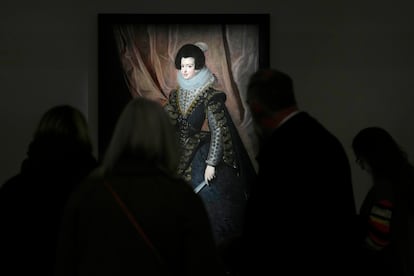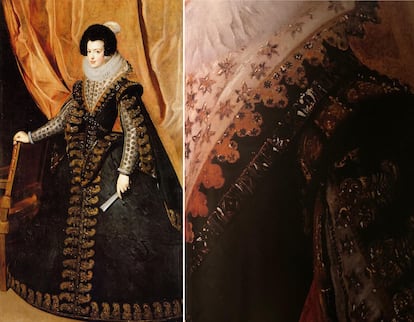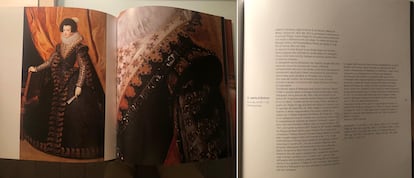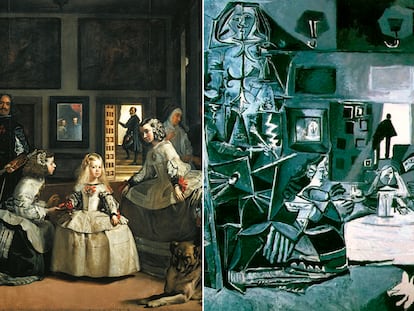The story behind the Velázquez set to be auctioned by Sotheby’s in 2024
The portrait of Queen Isabella of Bourbon has an estimated worth of $35 million. The painting, a rare piece, spent years in Madrid, Paris, the UK, and Naples, and is currently awaiting sale in New York

Next February, Sotheby’s auction house in New York plans to continue breaking million-dollar records with the sale of a large portrait of Queen Isabella of Bourbon, by the great 17th century Spanish painter Diego Velázquez. The estimated value of the painting is $35 million, but its price will ultimately be determined by auction during the so-called Masters Week, which on past occasions has seen paintings by Botticelli, for example, sell for upwards of $92 million. The latest canvas up for auction has a series of characteristics that make it a rarity on the art market, and thereby justify its stratospheric price tag. It is a rare and complicated affair for a painting by the famous Spaniard to go up for sale (the portrait is the most important work by Velázquez to come on the market in half a century, since the sale of another of his portraits, of Juan de Pareja). It is perhaps even rarer and more complicated to see a royal Velázquez painting go up for auction. This particular piece left Spain under unknown circumstances, during the War of Independence, and since the 19th century has travelled from Madrid to Paris, to the southern United Kingdom, passing through Naples, and is now being housed at Sotheby’s New York headquarters.
One of the earliest clues about the origins of the portrait of Queen Isabella can be found in the room where it hung in the Casón del Buen Retiro, one of the buildings in the palace complex where Philip IV resided, built at the behest of the Count-Duke of Olivares. No one knows exactly when it arrived at this location. Hanging next to the great painting were “a significant number of other works,” explains Javier Portús, head of pre-1800 Spanish Painting Conservation at the Prado Museum. Some were created especially for the space; others were brought from outside. “This painting, we know because of its typology, predates the Palace’s construction, so it would have arrived from somewhere else,” Portús says, referring to the Velázquez portrait, which dates from the early 1630s. What seems perfectly clear, according to the expert, is that the work was a royal commission. At the time, the main and most important client to contract Velázquez’s workshop was the monarchy.
The painting hung on a wall at the Casón del Buen Retiro until the beginning of Spain’s War of Independence (1808-1814). It is unknown when the painting of Queen Isabella left the palace on its way to France. There are several theories, says Portús, but none have been confirmed, because there are no documents to back up the claims, as is the case with many of the works housed in the palace complex that now hang in the Prado. During the conflict between the French and Spanish, “many paintings changed places and owners,” Portús says.

The plundering took place in different ways. On the one hand, Joseph Bonaparte, King of Spain, selected 50 works for the Bonaparte Museum to be returned to Spain as a result of the Treaty of Vienna. Then there was the so-called “baggage of King Joseph.” Portús explains: “Once they left Spain, those paintings were intercepted by the Duke of Wellington, and when he wanted to return them, Ferdinand VII decided that the British general should keep them.” Fernán Núñez, Spain’s representative in England, was in charge of responding on behalf of the king: “Enclosed is the official reply I have received from the Court, and from which I deduce that His Majesty, moved by your delicacy, does not wish to deprive you of what has come into your possession by fair and honorable means.” More than 80 of these works have been exhibited for years in the Wellington Museum at Apsley House in London. But the portrait of Queen Isabella was not one of them.
On the other hand, there is another possible explanation: that the generals and other soldiers in Napoleon’s army made their own deals. Or, perhaps, the departure of the Velázquez portrait was the work of one of the many art dealers of the era, who, as Portús explains, would wander around Spain in search of bargains. “A significant number of works emerged from that mess,” says the Prado Museum expert, who cites the example of The Arnolfini Portrait, by Jan van Eyck, a painting housed in the Royal Palace of Madrid in 1814 that is now on display at the National Gallery in London.
Second stop: Paris
The next time the painting went on display was in the Spanish gallery created by King Louis Philippe I at the Louvre Museum in Paris. On January 7, 1838, when the space was inaugurated, Parisians could view more than 400 paintings by Spanish artists, a collection curated by the French monarch himself. Among the works was the portrait of Queen Isabella by Velázquez. Just one decade later, in 1848, the Second Republic was established in France and the paintings made their way to Great Britain. It was there, in 1853, when “one of the most important auctions of the century” took place, in the words of Portús. It was at this auction that the painting passed into private hands for the first time. The British banker and collector Henry Huth bought lot 249, which remained in the hands of his family until 1950, when his heirs sold it.

In 1978, the painting changed hands again. It is not clear what happened between 1950, when the Huth family sold it, and when it came into the hands of its current owners, the Wildensteins, a dynasty of Jewish art dealers that began buying and selling art in the 19th century. This family of dealers, known for their problems with the law — for 15 years, they faced charges of fraud and tax evasion, in addition to being criticized for collaborating with a Nazi collector who sold works stolen from Jews — has boasted three Velázquez paintings in there collection. The one that Sotheby’s auctioned in February, a portrait of Ferdinando Brandani, was acquired by the Spanish government for 23 million euros in 2003, and Portrait of a Young Girl was sold by the Caylus gallery to an American collector.
In 2005, the Wildensteins lent the work to the Capodimonte Museum in Naples. To be displayed as part of a solo exhibition of Velázquez’s works, in which Benito de Navarrete, Professor of Art History at the Complutense University of Madrid, assisted in preparing the catalog descriptions. Speaking with EL PAÍS, Navarrete pointed out the page of the publication where his colleague Alfonso Pérez Sánchez explains that the portrait of Isabella of Bourbon is “the first signed version,” that is, it is the original work of the Spanish artist, not one of the later copies that were made of it. The painter portrayed the full figure of the Spanish monarch, in her early twenties and wearing an elegant black dress. The artist’s revisions, writes Christopher Apostle, Senior Vice President and Head of Department at Sotheby’s, were due to his “simultaneous desire” to modernize the image of the monarchs and to “demonstrate a new method of painting” influenced by his personal encounter with another great master of the era, Peter Paul Rubens.
Stopping the auction
In February, neither the Prado Museum nor the Ministry of Culture plans to buy the piece. Sources from both institutions confirmed to EL PAÍS that regulations prohibiting the plundering of art as spoils of war were developed in the twentieth century. But the case of the Velázquez piece predates those regulations. EL PAÍS consulted with three lawyers about the possibilities available to the Spanish government for attempting to stop the auction or to initiate litigation to try to return the painting to Spain. All three experts had the same answer: “It’s very complicated.” No UNESCO treaty applies, and the laws to which, for example, the heirs of Jewish families robbed by the Nazis are appealing, do not apply either.
“You can’t even use the case of the Portrait of the Marchioness of Santa Cruz as a precedent,” says Rafael Mateu, of the Ramón y Cajal law firm, about the work illegally taken from Spain in the early 1980s. “The state managed to stop the auction in London because of the fraudulent way in which it was sold abroad,” he explains. No one knows how the portrait of Queen Isabella left the Casón del Buen Retiro, but since that time, it has been exhibited as many as three times, and sold at various public auctions. As the three lawyers emphasized, the work was never hidden, and there has been plenty of time for Spain to attempt to reclaim it.

Sign up for our weekly newsletter to get more English-language news coverage from EL PAÍS USA Edition
Tu suscripción se está usando en otro dispositivo
¿Quieres añadir otro usuario a tu suscripción?
Si continúas leyendo en este dispositivo, no se podrá leer en el otro.
FlechaTu suscripción se está usando en otro dispositivo y solo puedes acceder a EL PAÍS desde un dispositivo a la vez.
Si quieres compartir tu cuenta, cambia tu suscripción a la modalidad Premium, así podrás añadir otro usuario. Cada uno accederá con su propia cuenta de email, lo que os permitirá personalizar vuestra experiencia en EL PAÍS.
¿Tienes una suscripción de empresa? Accede aquí para contratar más cuentas.
En el caso de no saber quién está usando tu cuenta, te recomendamos cambiar tu contraseña aquí.
Si decides continuar compartiendo tu cuenta, este mensaje se mostrará en tu dispositivo y en el de la otra persona que está usando tu cuenta de forma indefinida, afectando a tu experiencia de lectura. Puedes consultar aquí los términos y condiciones de la suscripción digital.
More information
Archived In
Últimas noticias
Most viewed
- Sinaloa Cartel war is taking its toll on Los Chapitos
- Oona Chaplin: ‘I told James Cameron that I was living in a treehouse and starting a permaculture project with a friend’
- Reinhard Genzel, Nobel laureate in physics: ‘One-minute videos will never give you the truth’
- Why the price of coffee has skyrocketed: from Brazilian plantations to specialty coffee houses
- Silver prices are going crazy: This is what’s fueling the rally










































